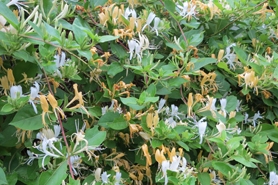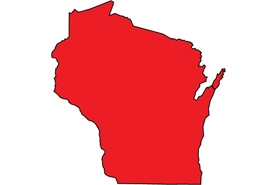Japanese honeysuckle
(Lonicera japonica)
Perennial, semi-evergreen, woody vine, up to 80' in length. Young stems are brown or red and usually pubescent. Older stems are woody and hollow, with bark that peels in long strips.
Other names for this plant include:
- Common names: Hall's honeysuckle vine, Chinese honeysuckle
- Scientific names: Lonicera aureoreticulata; Lonicera japonica var halliana; L. japonica halliana
Classification in Wisconsin: Prohibited
- Ecological Threat
-
- It Invades forests, prairies, fields and roadsides.
- Shrubs and young trees can be killed by girdling; Japanese honeysuckle vines twist tightly around stems and trunks.
- Identification
-
Leaves: Simple, opposite, oblong to oval, and 1 ½ -3" long. Leaves are sometimes lobed and may be covered with fine soft hairs. Leaves persist on the vine until mid-winter.
Flowers: Borne in pairs at leaf axils; tubular and fragrant. White to pink flowers turn yellow with age. Bloom late spring to early summer.
Fruits & seeds: Small, ¼" purple-black berries are produced in fall and occur along the stems in the leaf axils. Birds and mammals disperse them.
Roots: Produces underground rhizomes and long, aboveground stolons that develop roots where nodes contact the soil.
Similar species: Native honeysuckle vines have red or orange berries, flowers at the tips of stems and connate leaves (fused to form a single leaf through which the stem grows) below flowers.
- Control
-
Mechanical: Pull or repeated mowing followed up by chemical control. Fire may kill seedlings and set back older plants.
Chemical: Treat foliage with glyphosate or triclopyr amine in the fall when native plants are dormant. Where plants grow off the ground, cut vines just above the soil surface and treat them immediately with glyphosate or triclopyr amine.
For more information on control techniques, visit the Japanese honeysuckle factsheet [exit DNR] by the University of Wisconsin-Extension.
- Resources
- Sources for content:
- Czarapata, Elizabeth; Invasive Plants of the Upper Midwest: an illustrated guide to their identification and control. The University of Wisconsin Press. 2005. Pg. 129-130
- Bravo, Melissa. Plant Conservation Alliance Factsheet: Japanese honeysuckle [exit DNR]. Last updated June 27, 2006.
- Center for Invasive Species and Ecosystem Health: Invasive.org. Last updated on May 4, 2010. Japanese honeysuckle [exit DNR].


